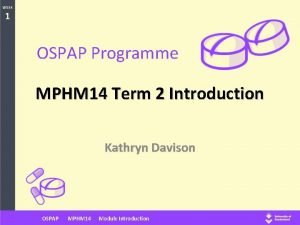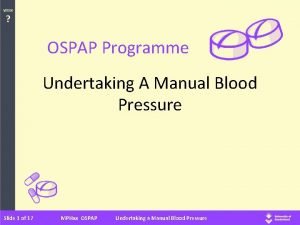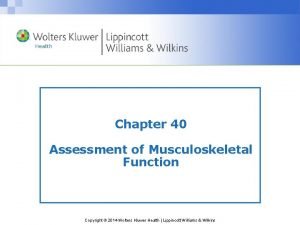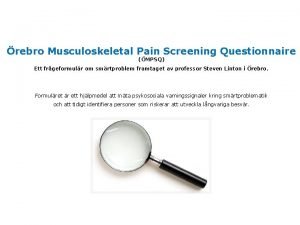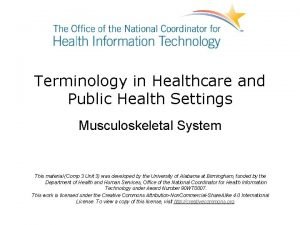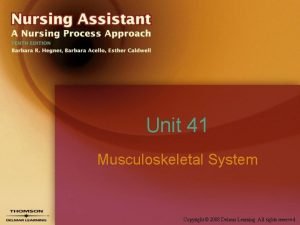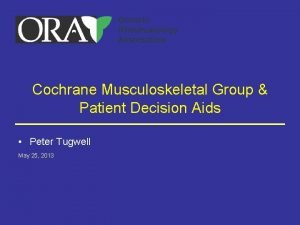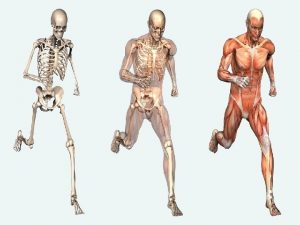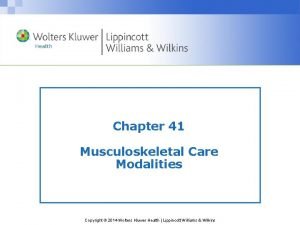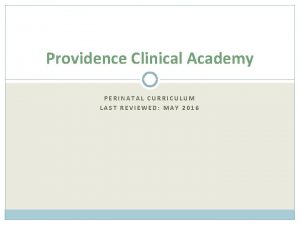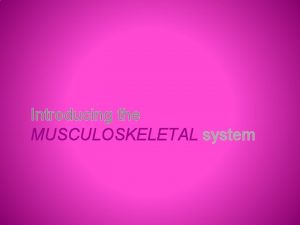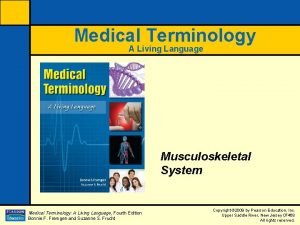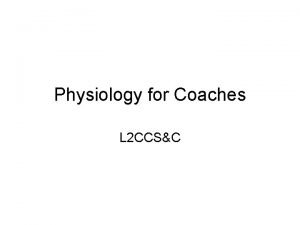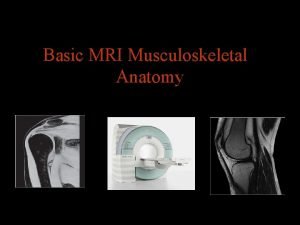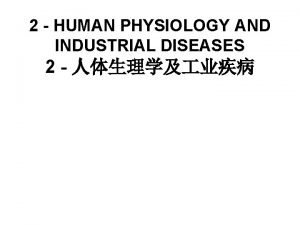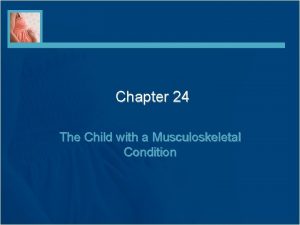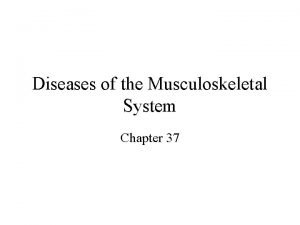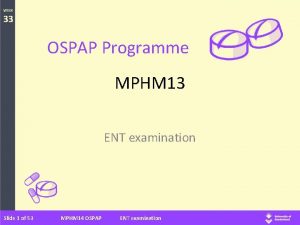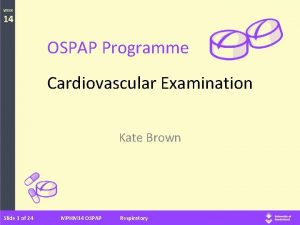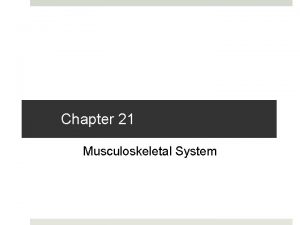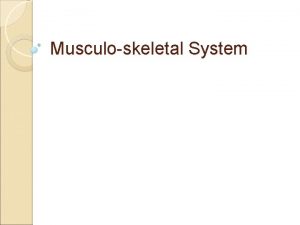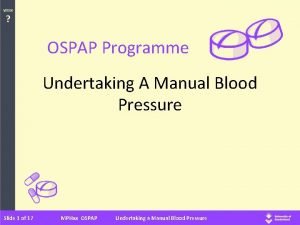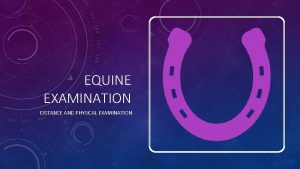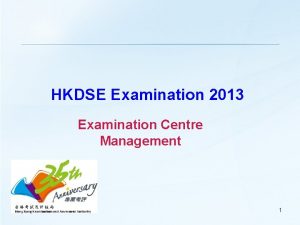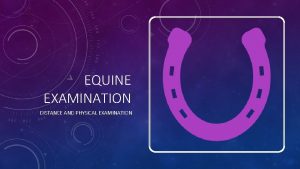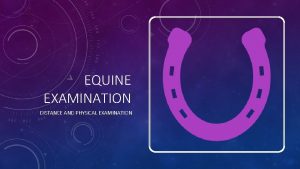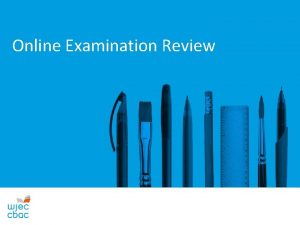WEEK OSPAP Programme OSPAP Musculoskeletal examination Slide 1


























- Slides: 26

WEEK ? OSPAP Programme OSPAP Musculoskeletal examination Slide 1 of 17 MPHxx OSPAP Undertaking a Manual Blood Pressure

WEEK ? Response to Injury Bruising Haematoma Redness Inflammation Wounds Deformity Effusion Pain Slide 2 of 17 MPHxx OSPAP Swelling Undertaking a Manual Blood Pressure

WEEK Common Injuries ? • Sprain (stretching of ligaments) • Strain(stretching or tearing of tendons/muscle fibres) Slide 3 of 17 MPHxx OSPAP Undertaking a Manual Blood Pressure

WEEK Strain ? Slide 4 of 17 MPHxx OSPAP Undertaking a Manual Blood Pressure

WEEK Fracture ? Slide 5 of 17 MPHxx OSPAP Undertaking a Manual Blood Pressure

WEEK Dislocation ? Slide 6 of 17 MPHxx OSPAP Undertaking a Manual Blood Pressure

WEEK REMS ? • • Slide 7 of 17 Look at the joint/s Feel the joint/s Move the joint/s Assess the function of the joint/s MPHxx OSPAP Undertaking a Manual Blood Pressure

WEEK LOOK ? • The affected area should be exposed and compared with the unaffected side. • Examine for any; – Swelling – Inflammation – Deformities – Differences in size Slide 8 of 17 MPHxx OSPAP Undertaking a Manual Blood Pressure

WEEK FEEL ? • Check skin temperature • Check/ask about areas of tenderness • Check any swellings for fluctuance and mobility Slide 9 of 17 MPHxx OSPAP Undertaking a Manual Blood Pressure

WEEK MOVE ? • Depending on the joint, a full range of movement should be assessed. • Assess both active (firstly) and passive (secondly) movements • During passive movements one hand to remain on joint for crepitations etc Slide 10 of 17 MPHxx OSPAP Undertaking a Manual Blood Pressure

WEEK FUNCTION ? • Conduct a functional assessment of the affected joint/limb • Movement against resistance (use caution due potential underlying injury) Slide 11 of 17 MPHxx OSPAP Undertaking a Manual Blood Pressure

WEEK ? Movements always described from neutral position: • Flexion – bending at a joint from the neutral position (reduces angle) • Extension – straightening a joint back to the neutral position (opposite at same joint) • Hyperextension – movement beyond the normal neutral position because of a torn ligament or underlying ligamentous laxity • Adduction – movement towards the midline of body • Abduction – movement away from midline Slide 12 of 17 MPHxx OSPAP Undertaking a Manual Blood Pressure

WEEK ? Slide 13 of 17 MPHxx OSPAP Undertaking a Manual Blood Pressure

WEEK ? Slide 14 of 17 MPHxx OSPAP Undertaking a Manual Blood Pressure

WEEK ? Slide 15 of 17 MPHxx OSPAP Undertaking a Manual Blood Pressure 15

WEEK Examination ? • Ankle • Knee • Hand/wrist Slide 16 of 17 MPHxx OSPAP Undertaking a Manual Blood Pressure

WEEK Examination of the ankle ? With the patient sitting down you should expose the joint and compare with unaffected side. Look (inspection) • Look around whole of ankle and foot including the base of foot – – – – Scars Swelling Redness Atrophy Rash Deformity Difference in size compared to unaffected limb Feel (palpation) • Observe patient throughout for signs of pain. Ask patient to report pain • Locate medial and lateral malleolus and navicular- palpate for bony tenderness • Palpate over the whole foot, along each metatarsal and identify: – – – Temperature of skin Tenderness Swelling Crepitus Bony enlargement Move • Active and passive (unless possibility of fracture) – – – Flexion Extension Inversion Eversion Rotation Function • Resisted movement • Walk 5 steps Slide 17 of 17 MPHxx OSPAP Undertaking a Manual Blood Pressure

WEEK Ottowa Rules- Ankle Ottawa ankle ? (Ottawa ankle rules for use of radiography in acute ankle injuries (adapted from Stiell et al 1995) Slide 18 of 17 MPHxx OSPAP Undertaking a Manual Blood Pressure

WEEK Examination of the Knee ? With the patient sitting/lying down you should expose the joint and compare with unaffected side. Look (inspection) • Look around whole of the knee, including behind in the popliteal fossa – – – – Scars Swelling Redness Atrophy Rash Deformity Difference in size compared to unaffected limb Feel (palpation) • Observe patient throughout for signs of pain. Ask patient to report pain • Palpate the patella, head of tibia & fibula, collateral ligaments and menisci • Palpate generally for: – – – Temperature of skin Tenderness Swelling Crepitus Bony enlargement Move • Active and passive (unless possibility of fracture) • Flexion • Extension Function • Resisted movement • Walk 5 steps Slide 19 of 17 MPHxx OSPAP Undertaking a Manual Blood Pressure

WEEK ? Slide 20 of 17 Ottowa Rules – Knee Ottawa knee MPHxx OSPAP Undertaking a Manual Blood Pressure

WEEK ? Examination of the hand/wrist Position the patient in a comfortable position allowing visualisation of both hands together. Look (inspection) • Dorsal aspect (back of hand) and palmar aspect (palm of hand) – – – Scars Swelling Redness Atrophy Rash Deformity at wrist and metacarpal joints Feel (palpation) Observe patient throughout for signs of pain. Ask patient to report pain • Locate radius and ulnar. • Locate wrist groove and feel carpal bones. Feel 5 metacarpal bones and down each proximal interphalangeal joint medial and laterally for: – – – Slide 21 of 17 Temperature of skin Tenderness Swelling Crepitus Bony enlargement MPHxx OSPAP Move Active and passive (unless possibility of fracture) • Wrist: – Flexion – Extension – Ulnar deviation – Radial deviation • Hand: – Flexion (Make a fist) – Extension (Straighten) – Abduction (Spread fingers) – Thumb opposition Function • Hand function/grip strength • Power/resistance Undertaking a Manual Blood Pressure

WEEK Advice ? • PRICE & HARM Slide 22 of 17 MPHxx OSPAP Undertaking a Manual Blood Pressure

WEEK P. R. I. C. E ? • P - protection (weakened tissue & supports new fibres) • R - rest (usually 2 days dependent on injury) • I - ice (first few hours only & crushed on wet cloth) • C - compression (aid venous return & not compromise arterial) • E - elevation (reverse swelling & not combined with compression) Slide 23 of 17 MPHxx OSPAP Undertaking a Manual Blood Pressure

PRICE WEEK ? • Protect the injured part from further injury. The site of the injury will determine how best to protect it. • Rest the affected joint or muscle for 48 -72 hours following injury. For example, consider the use of crutches for an ankle, knee or leg injury. • Ice - the cold from the ice is thought to reduce blood flow to the damaged ligament or muscle. This may limit pain and inflammation: Ice should be applied as soon as possible after injury. Wrap the ice in a damp towel and apply it to the injured area for 15 -20 minutes. A bag of frozen peas is an alternative. Gently press the ice pack on to the injured part. This should be done every 2 -3 hours during the day, for the first 2 -3 days after the injury. (Do not put ice directly next to skin, as it may cause ice burn. Also, do not leave ice on while asleep, and do not apply it for more than 30 minutes, or it may damage the skin. ) • Compression with a bandage will limit swelling, and help to rest a joint. A tubular elastic bandage or a simple elasticated bandage is suitable for most joints. A pharmacist will advise on the correct type and size. The bandage should feel snug, but not uncomfortable or tight, and should not stop blood flow. Remove before going to sleep. You may be advised to remove the bandage for good after 48 hours, so that the joint can move. However, sometimes it is advisable to kept the bandage on for longer, to help lessen the swelling and to keep the joint more comfortable. • Elevation aims to limit and reduce any swelling. For ankle and knee sprains, keep the foot up on a chair to at least hip level when you are sitting. (It may be easier to lie on a sofa and to put your foot on some cushions. ) When you are in bed, put your foot on a pillow. For hand or wrist sprains, use a sling with your hand wrist higher than your elbow. Slide 24 of 17 MPHxx OSPAP Undertaking a Manual Blood Pressure

WEEK HARM ? Avoid HARM for 72 hours after injury: • Heat - for example, hot baths, saunas, heat packs. Heat has the opposite effect on the blood flow to ice. That is, it encourages blood flow. So, heat should be avoided when inflammation is developing. However, after about 72 hours, no further inflammation is likely to develop and heat can then be soothing. • Alcohol drinks which can increase bleeding and swelling and decrease healing. • Running or any other form of exercise which may cause further damage. • Massage which may increase bleeding and swelling. However, as with heat, after about 72 hours, gentle massage may be soothing. Slide 25 of 17 MPHxx OSPAP Undertaking a Manual Blood Pressure

WEEK Any Questions ? Slide 26 of 17 MPHxx OSPAP Undertaking a Manual Blood Pressure
 Heel and toe polka dance
Heel and toe polka dance University of sunderland ospap
University of sunderland ospap Ospap
Ospap Week by week plans for documenting children's development
Week by week plans for documenting children's development Assessment of the musculoskeletal system
Assessment of the musculoskeletal system Gonarthrosis arthrosis of knee
Gonarthrosis arthrosis of knee ömpsq
ömpsq Chapter 21 the musculoskeletal system
Chapter 21 the musculoskeletal system Musculoskeletal pronounce
Musculoskeletal pronounce Unit 41 musculoskeletal system
Unit 41 musculoskeletal system Cochrane musculoskeletal group
Cochrane musculoskeletal group Spine pathology
Spine pathology Muscle strength scale
Muscle strength scale Chapter 41 musculoskeletal care modalities
Chapter 41 musculoskeletal care modalities Microganthia
Microganthia Musculoskeletal system
Musculoskeletal system Clasia medical term
Clasia medical term Musculoskeletal system
Musculoskeletal system Musculoskeletal mri anatomy
Musculoskeletal mri anatomy Musculoskeletal
Musculoskeletal Musculoskeletal system
Musculoskeletal system Chapter 24 the child with a musculoskeletal condition
Chapter 24 the child with a musculoskeletal condition Musculoskeletal integrity
Musculoskeletal integrity Chapter 6 musculoskeletal system diseases and disorders
Chapter 6 musculoskeletal system diseases and disorders Diseases of the musculoskeletal system
Diseases of the musculoskeletal system Musculoskeletal surgery ayr
Musculoskeletal surgery ayr Musculoskeletal icd 10
Musculoskeletal icd 10

